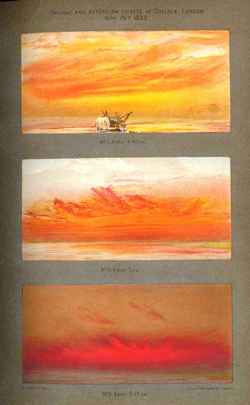
The eruption of Krakatoa and subsequent phenomena: report of the Krakatoa Committee of the Royal Society, edited by G.J. Symons (1888)
Geoscientist 21.1 February 2011
Michael McKimm writes: As hoards of people rushed with digital cameras to capture the terrific sunsets this April, when the ash from Eyjafjällajökull stretched over northern Europe, so in 1883 painters readied their easels as the after-effects of the eruption of Krakatoa produced stunning light-shows all over the world.
The drawings shown here, the frontispiece to the Royal Society 1888 report on Krakatoa, are reproduced from crayon sketches made on the bank of the Thames on 26 November 1883 by Mr W. Ashcroft. They illustrate the appearance of the sunset three months after Krakatoa’s blast, a phenomenon which was echoed in observations from places as far apart as central America and Scandinavia, where affiliates of the Royal Society avidly documented the startling skies: “a misty, rippled surface of haze, with faint crimson hue, which at the edges of the circle gave a purplish tint against the blue sky” (England); “from a delicate pink to a very intense scarlet” (Australia); “the general colour became peculiar and blue-leaden” (Ceylon); “the crimson glow on the sky flooded the western sides of the buildings with an unearthly light, and cast faint shadows across the snow” (Ohio); a “sickly greenish yellow” (South Africa); “one could imagine oneself in Fairyland” (Germany).
An engrossing document of the geological, meteorological, seismic and magnetic implications of the eruption, the report is also a fascinating insight into the global reach of a scientific organisation in the Victorian period, as world-encompassing as Krakatoa’s ash itself.
- The Library operates a sponsorship scheme to help preserve and restore its rare books. For more information, contact Michael McKimm in the library, or see the Sponsor A Book page on the Society’s website: www.geolsoc.org.uk/sponsorabook